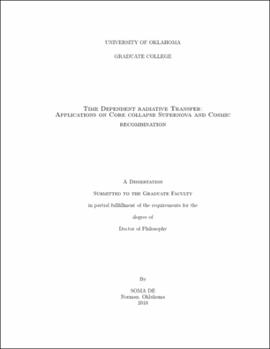| dc.contributor.advisor | Baron, Edward | |
| dc.creator | De, Soma | |
| dc.date.accessioned | 2019-04-27T21:37:42Z | |
| dc.date.available | 2019-04-27T21:37:42Z | |
| dc.date.issued | 2010 | |
| dc.identifier | 99356933302042 | |
| dc.identifier.uri | https://hdl.handle.net/11244/319202 | |
| dc.description.abstract | I have conducted my PhD dissertation research at the department of Physics and As- | |
| dc.description.abstract | tronomy at the University of Oklahoma. My thesis adviser, Dr Eddie Baron, and Peter Hauschildt | |
| dc.description.abstract | (Hamburger Sternwarte, Germany) have developed an advance d general purpose stellar atmosphere | |
| dc.description.abstract | code PHOENIX (Hauschildt et al., 1997) over the past many years. Most of my dissertation research | |
| dc.description.abstract | involves working extensively on PHOENIX primarily for SNe related applications. Motivation for | |
| dc.description.abstract | the first project was to investigate the importance of time-dependence in the type II SNe atmo- | |
| dc.description.abstract | spheres. It is claimed that the hydrogen recombination time increases due to Lα trapping and | |
| dc.description.abstract | ionization from the second level and therefore it is necessary to incorporate time dependence to | |
| dc.description.abstract | reproduce the Balmer profile of SN 1987A early spectra (Utrob in and Chugai (2005), Dessart and | |
| dc.description.abstract | Hillier (2008)). I implemented time dependence in the rate equations for different species and | |
| dc.description.abstract | added the 2s-1s non-resonant transition in PHOENIX in order to explicitly estimate the recombina- | |
| dc.description.abstract | tion time. I generated the time dependent profiles for the ionization fraction, recombination time | |
| dc.description.abstract | and spectra for SN 1987A and SN 1999em. For SN 1987A and SN 1999em I started respectively at | |
| dc.description.abstract | 2 and 7 days following the explosion and generated time dependent profiles at intervals of 2-4 days | |
| dc.description.abstract | upto 20 and 40 days (since explosion) respectively. I compared the observed spectra for SN 1987A | |
| dc.description.abstract | with the synthetic spectra generated from both time dependent (TD) and time independent (TI) rate | |
| dc.description.abstract | equations using a 31 level hydrogen atom model. Based on my comparison I concluded that 1) | |
| dc.description.abstract | the Balmer profile in SN 1987 A spectra could be produced without TD by tuning the input lumi- | |
| dc.description.abstract | nosity at all epochs and 2) TD is more important at early epochs than later ones. I also compared | |
| dc.description.abstract | the recombination times from a 4-level hydrogen atom model t o that from the multi-level cases. I | |
| dc.description.abstract | concluded that it is very important to include many angular momentum sub-states to get a realistic | |
| dc.description.abstract | estimate of the recombination time which is overestimated if the additional angular momentum | |
| dc.description.abstract | sub-states are ignored. These results have been described i n detail in De et al. (2009). I have also | |
| dc.description.abstract | studied the effects of non-resonant transitions (De et al. 2009 in preparation) and concluded that | |
| dc.description.abstract | these effects are more important in a multi-level atomic fra mework in a metal-deficient environ- | |
| dc.description.abstract | ment. Recently I have been modifying PHOENIX to apply it to study the cosmic recombination | |
| dc.description.abstract | epoch and implementing Compton scattering. The idea is to generate an accurate time-dependent | |
| dc.description.abstract | variation of the ionization fraction of the universe during the recombination era which strongly | |
| dc.description.abstract | affects the CMB polarization and power spectra. In addition to working on radiative transfer prob- | |
| dc.description.abstract | lems I have worked on the cosmological dark matter density field during my graduate school years | |
| dc.description.abstract | at Carnegie Mellon University under my then adviser Dr Ruper t Croft. I investigated how statistical | |
| dc.description.abstract | measures derived from the dark matter mass density field coul d predict cosmological parameters | |
| dc.description.abstract | independent of uncertainties from galaxy formation theori es (De and Croft, 2007) and applied this | |
| dc.description.abstract | to the 2dF redshift survey to constrain the cosmological par ameters (De and Croft, 2009). | |
| dc.format.extent | 113 pages | |
| dc.format.medium | application.pdf | |
| dc.language | en_US | |
| dc.relation.requires | Adobe Acrobat Reader | |
| dc.subject | Radiative transfer | |
| dc.subject | Supernovae | |
| dc.subject | Cosmology | |
| dc.title | Time dependent radiative transfer: Application on core collapse SNe and cosmic recombination | |
| dc.type | text | |
| dc.type | document | |
| dc.thesis.degree | Ph.D. | |
| ou.group | College of Arts and Sciences::Homer L. Dodge Department of Physics and Astronomy | |
